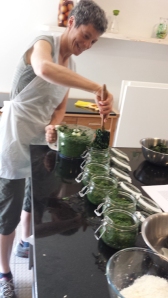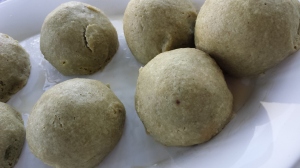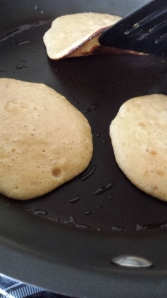What an exciting opportunity I got – to lead some urban foraging workshop for a London-based community centre this spring. This will also result in some joint posts with my other blog where J and I post about our foraging experiences.
The first workshop is ‘Pick & Mix Will Herbs’ and focused on Wild Garlic and Stinging Nettles. For logistical reasons, and because of the warm and early spring, I only took the group to pick Wild Garlic. The Nettles will have already been too bitter at this point and most have already been through blossom and gone to seed. My solution was to pick, blanch and freeze early season nettles so they are good to go for the workshop day.
We started the workshop in Mill Hill, where the wild garlic ad already flowered and gone to seed, but the leaves were still very fragrant and good to pick.



We then continued to JW3 which was buzzing with activity, to cook with our herbs.


JW3 London has a beautiful, well equipped demonstration kitchen so after foraging the wild garlic we reconvened at JW3 HQ and made Wild Garlic Pesto (edited recipe below). I wanted the participants to have something to take home with them so each person got a jar of the pesto they just made but we also demonstrated how the pesto can be used to flavour a risotto dish and a simple and seemingly ambitious soufflé.
At the end of the workshop we enjoyed the fruit of our labour and a lovely lunch together.

These are the recipes we learnt on the day:
Wild Herb Pesto:
Makes aprox 0.5 l
Ingredients:
2 large bunches Wild Garlic (Ramson)
1 bunch Stinging Nettles
100g Walnuts
50g Parmesan Cheese (optional)
2-3 Garlic cloves
150ml Olive Oil
Salt to taste
Method:
- Heat the oven to 150˚c. Place the walnuts on a baking sheet and roast in the oven until golden, shaking after five and seven minutes to make sure they brown evenly and don’t burn. You can also do that in a dry pan on a medium heat but I prefer using the oven.
- Once the Walnuts are browns place them, along with the rest of the ingredients in a food processor and process until smooth, then season to taste. You could also make your paste the traditional way, using a pestle and mortar.
- Sterilise your storage jar and pour the pesto into it. Cover with a little extra olive oil and seal. Store in the fridge for up to two weeks. Alternatively, pour the pesto into ice-cube trays and freeze, then transfer the frozen cubes to a bag and keep in the freezer to use when needed.
– The following recipes are NOT Specific Carbohydrate Diet friendly as the ingredient used are grain based –
For a SCD friendly Risotto recipe follow this link
White Risotto with Wild Herb Pesto:
Based on a recipe by Jamie Oliver
Serves 6
Ingredients:
1 liter Stock (I used vegetable, made from a stock cube as it was the most practical way at the demo)
2tbsp Olive Oil
a knob of Butter (aprox 25g)
1 large Onion
2 cloves Garlic
1/2 head of Celery
400g Risotto Rice
350ml Dry White Wine
Salt and Pepper to taste
50g Butter
50g Parmesan Cheese
a handful of toasted Pine Nuts to decorate (or use some of the toasted walnuts you used to make the pesto)
Method:
- Heat the stock and Finely chop the onion, celery and garlic.
- Heat the olive oil and butter in a saucepan. Add the chopped onion, garlic and celery and cook on a medium heat very slowly for about 15 minutes without colouring. When the vegetables have softened, add the rice and turn up the heat.
- The rice will start to fry so keep stirring it. After a minute it will start looking a little translucent. Add the wine and keep stirring.
- Once the wine has cooked into the rice add the first ladle of stock and a good pinch of salt. Turn the heat down to a simmer so the rice doesn’t cook too quickly and unevenly. As the rice cooks it will soak up the stock, so keep adding ladlefulls of stock, one at a time while stirring it in to develop the starch. Continue doing that for about 15 minutes, until the rice is soft but with a slight bite. If you run out of stock, add some boiling water.
- Remove from the heat and stir in the 50g butter and parmesan. Place a lid over the pan and allow to sit for 2 minutes. This will turn the risotto creamy and oozy like it should be. Check seasoning and amend if necessary.
- Divide the risotto between your plates and top with a generous dollop of the wild herb pesto. Decorate with some wild garlic flowers (if available) and the toasted nuts and drizzle some olive oil.
Wild Herb Soufflé:
Makes 8 individual soufflés
Ingredients:
For the Béchamel Sauce:
20g butter
1tbsp plain flour
150ml Milk
Salt to taste
For the Soufflé:
350g Nettle tops, washed and blanched. Finally chopped
100g Wild Garlic leaf, washed and finely chopped
1 heaped tbsp wild herb pesto
150ml béchamel sauce
10 sun-dried tomatoes, roughly chopped (optional)
8 mushrooms (optional, use any verity you like), shallow fried and roughly chopped
4 medium eggs (yolks and whites separated)
35g hard strong cheese (like parmesan, optional), grated, plus a little for lining the ramekins
Melted butter – enough to line the ramekins
Salt and pepper to taste
Method:
- Make the béchamel sauce: In a medium-sized saucepan melt the butter, then add the flour and a pinch of salt, and stir well using a wooden spoon. Let the butter and flour cook for a minute or two, stirring constantly with a wooden spoon. Start adding the milk, a bit at a time, constantly stirring to dissolve the flour mix without leaving lumps. Cook over a medium heat, constantly stirring, until the sauce thickens to the consistency of custard. Leave to cool slightly and start preparing the soufflé
- Roughly chop the mushrooms and fry with a little oil until cooked. Remove from the heat and set aside to cool.
- Heat the oven to 220°C. Brush the inside of the ramekins with melted butter and coat with a little grated cheese. Divide the sun-dried tomatoes and mushrooms equally between the ramekins, placing a little in the bottom of each.
- Beat the egg yolks and stir them into the béchamel sauce (make sure it’s cool enough so the yolks don’t cook and become lumpy in the sauce), then mix in the nettles, wild garlic and pesto. Adjust seasoning if necessary.
- Beat the egg whites until stiff, then fold the nettle mixture into the egg whites and scrape into the ramekins, filling them to the top. Level off with a knife and run your fingertip around the very edge of each ramekin to make a groove in the mix (helps it rise evenly). Sprinkle over a bit of grated cheese.
- Bake for 12 minutes and serve immediately.
Enjoy!






























